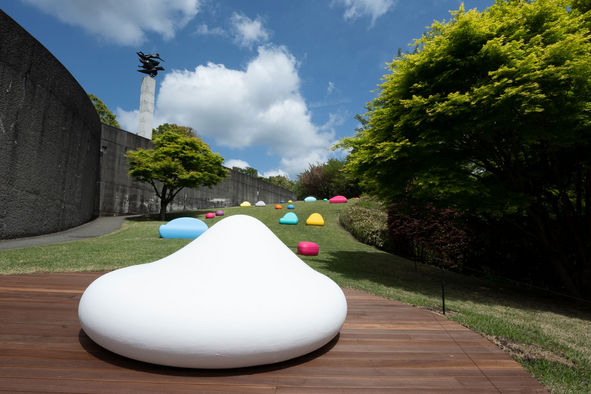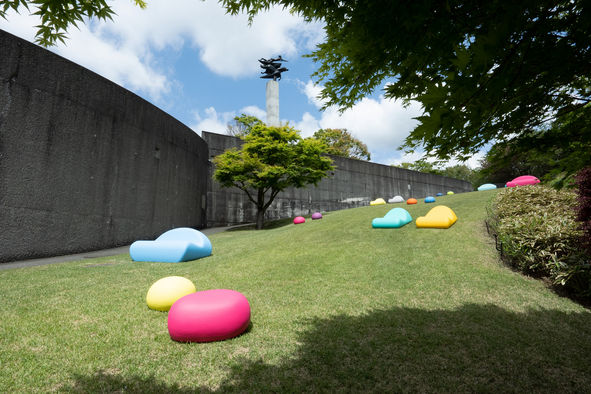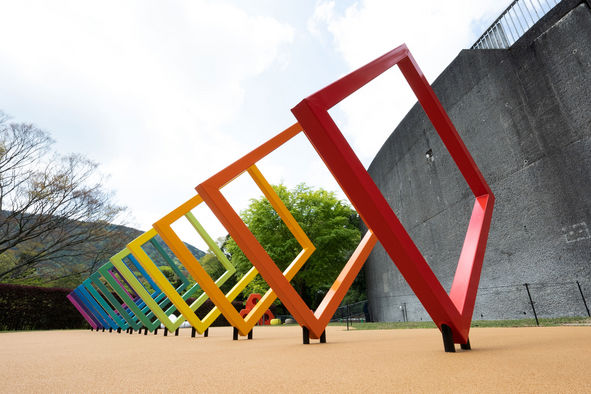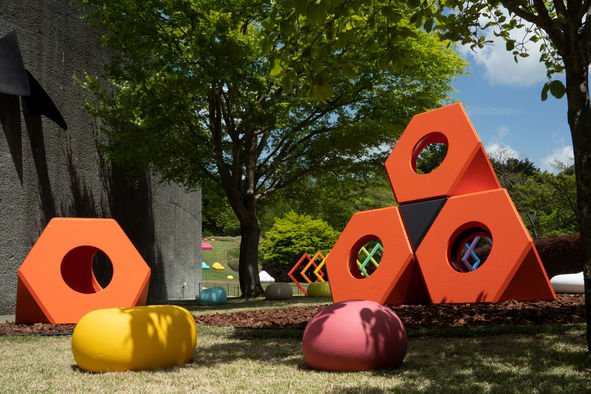
Sculpture and lawn resting area
"Poketto.
In April 2021, "Poketto," an area where visitors can take a break and enjoy interactive artworks, opened at the Open-Air Museum of Sculptures. is an area where visitors can take a break and enjoy interactive artworks.
Behind the wall of the large Bourdelle work that immediately catches the eye upon entering the museum, a space like a secret base created by the difference in elevation of the terrain spreads out.
There, visitors can use their bodies, take pictures, listen to the sound of the wind, and enjoy the colorful works on display as they experience the area. The area's characteristic grassy lawn will also be furnished with colorful sofas to provide visitors with a relaxing time.
Please enjoy the blue sky overhead and the view of Hakone while poking around in the pockets surrounded by art.

- Area name:
- PockeT. (Japanese) PockeT. (English)
- Opening Date:
- April 29, 2021 (Thursday)
- Works on Display:
- Shigeo Matsubara, "Cosmic Color Space"
Isamu Noguchi, "Octetra"
Akinori Matsumoto, "Music Played by Wind" - Landscape Design:
- ARIWRKS
- Furniture Production:
- SIXINCH Inc. Japan
- Area naming and logo design:
- Yoshinori Takamura (CRAFTIVE)
Exhibited Works

Isamu Noguchi "Octetora"
American sculptor Isamu Noguchi created numerous play sculptures to bring art into the everyday playground and give children dreams.
Octetra is the best known of his place sculptures. Named "Octetra" from the Greek 8 = octo and 4 = tetra, it is an octahedral sculpture with four hexagonal faces and four triangular faces that visitors can climb inside and climb through.

Shigeo Matsubara, "Cosmic Color Space,"
Matsubara says, "By juxtaposing objects, space is connected, and an ordered cosmic space is created by merging with the nature outdoors. In this work, squares of the same size are arranged in a row and painted in a rainbow of colors: red, yellow, green, and blue. 12 different colors create a rhythm and harmony, creating a microcosm of color that seems as if it could be heard. The open space created by the series of square frames seems to draw the viewer unintentionally into the work.
This work, which makes not only children but also adults want to pass through the frames, serves as an environmental sculpture that soothes people's feelings, and also as a playground sculpture that transcends the artist's intent.

Akinori Matsumoto "Music of the Wind"
When the wind blows, you can hear a simple clanging sound coming from far above your head. When you look up, you see many pipes swaying in the wind, standing side by side with the surrounding grove of trees. The sound produced by the wind is the rhythm of nature. The pipes, made of aluminum and varying in length, create music with highs and lows in sound. For example, in light winds, they produce a gentle music like the whisper of the wind. I am self-taught in art and music.
I love music. But I can't play a conventional instrument such as piano or guitar. I have been studying the performing arts of ethnic minorities in seven Asian countries for a year and a half since 1992.
In recent years, he has been creating sound objects made of bamboo and presenting them in shadow puppet-style sound installations inspired by Asian performing arts.
Area Concept
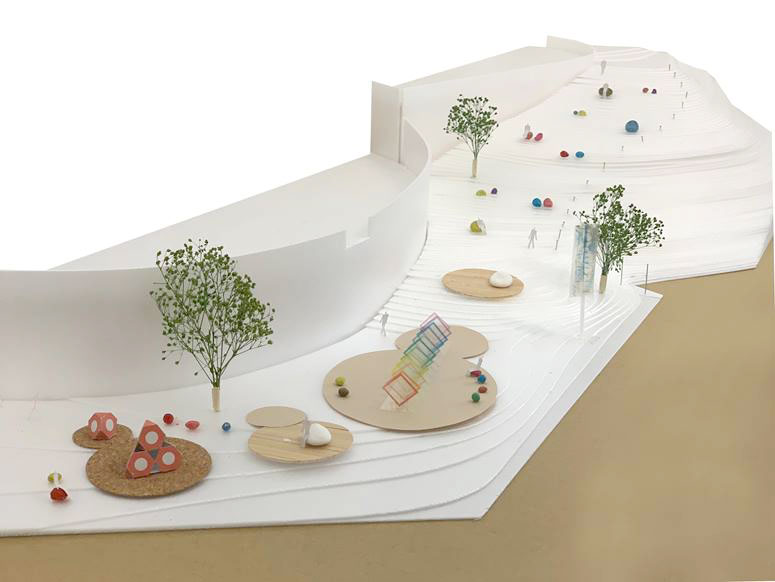
The proposed site is located exactly in the middle of the ground created by the difference in elevation of the site of the Open-Air Museum, and is visually separated from the other areas on the ground above and below.
Against the rough concrete retaining wall connecting the difference in elevation and the large sloping lawn surface, trees and mountains leading to Sagami Bay and the big sky spread out before one's eyes. In this natural setting, separated from the rest of the building, a new landscape emerges with colorful outdoor furniture of various shapes for sitting, lounging, and resting, and colorful sculptures to touch, climb, and experience.
The wooden deck becomes a stage and exhibition space for workshops and exhibitions, while the slope and outdoor furniture become seating areas. A circular soft floor was created with rubber and bark chips around the interactive sculptures, and a circular floor was created with wood decking around the large outdoor furniture.
The intention is to create expression and movement in the space by connecting and separating these circles of various materials, sizes, and shapes.
(ARIWRKS)
Naming Concept
Poketto. has two meanings.
The location of the building, on a slope connecting the entrance to the circular plaza and a lower area at the back of the building, is like a "pocket" of the Mori Art Museum. And, while most of the zoning is based on outdoor tours, it is possible to stay here and spend time "poking around" as one pleases. The "pocket" is a place where people can spend their time in a relaxed atmosphere.
We hope that the people who use the space will have their own "poketto. I hope that the people who use these zones will have their own "Poketto.
Yoshinori Takamura (CRAFTIVE)
